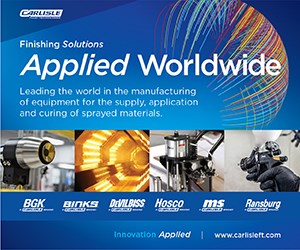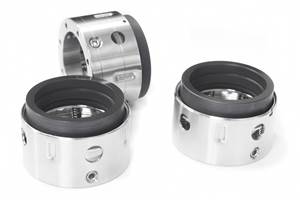Reducing Contamination in Your Finishing Application
Justin Hooper of Carlisle Fluid Technologies offers insights for mitigating defects when using 2K urethane paint.
Q: Our paint line currently uses multiple HVLP guns to spray a high solids 2K urethane paint. We are noticing contamination or defects on the surface of our parts that only appear near the end of our shift each day. What could be causing this and how can we fix it?
A: I’m glad you have been able to isolate that the issue is happening near the end of the shift, so we want to consider what changes occur from when you first start up your production line. While your 2k paint is being sprayed throughout the day, you want to pay attention to your overspray (basically any paint not sticking to the part). 2K paints, when dry, are very difficult to clean from the surface they have dried on, so a common area to check is your spray gun. During the shift, it is essential to keep your gun and air cap clean. Every time you have a break, we recommend cleaning the air cap of your spray gun. If your air cap gets a lot of paint buildup, you might need to do more cleaning later in the shift than a simple wipe-down at the beginning of the shift. If the air cap holes become clogged, it could affect the atomization of the paint, which could produce inconsistent gloss or even slugs of paint on your part that could be the contamination you are finding.
The next common area that can cause contamination on your parts toward the end of your shift is a change in the airflow of your booth. Filters can get clogged from excess overspray, which could reduce or change the airflow of your paint booth. Overspray paint can also dry out and swirl inside your booth until it lands on your freshly painted part. This can be referred to as dry spray and can add a texture to the surface of parts. To help reduce this issue, make sure filters are being replaced when they become clogged with paint or when your spray booth manometer readings state a filter change is needed. Also, look to adjust the settings on your spray guns to help reduce the overspray. The easiest way to do this is to ensure the least amount of fluid flow and atomization air are used while still providing the desired finish quality and production speed you need to achieve.
Finally, if contamination is caused by one of the above suggestions, a longer-term solution could be to research more efficient spray guns. If your HVLP spray guns are more than 10 years old (or the gun was introduced to the marketplace more than 10 years ago), there have been a lot of advancements in the efficiencies of newer HVLP guns. These guns can achieve the desired finish quality with higher production rates while significantly reducing the overspray and saving a lot of money, not just on rework but on paint reduction. Depending on your application, other options would be to look at electrostatic air spray equipment or rotary bell application equipment. These applicators can reduce your paint usage by 30-70% while maintaining the film thickness, finish quality and production rates required by your production line.
We recommend contacting your spray equipment provider or paint gun manufacturer for improvement options. Many of these companies have testing labs allowing your part and your paint to be tested to prove the differences in paint usage and overspray with different application equipment. Keeping a cleaner spray booth allows you to go each shift without consistently having contamination issues.
About the Author

Justin Hooper
Justin Hooper is the global product manager for automation for Carlisle Fluid Technologies. Visit carlisleft.com.
Related Content
How to Avoid Mud Cracking
Julie Holmquist of Cortec Corporation discusses ways to avoid mud cracking defects when applying anticorrosion coatings.
Read MorePretreatment for Painting
Better adhesion, enhanced corrosion and blister resistance, and reduced coating-part interactions make pretreatment a must.
Read MoreSurface Prep Solution for Rusted Rebar in Concrete
Julie Holmquist of Cortec Corporation discusses passivating corrosion on rebar and other reinforcing metals.
Read MoreUnique Coating Reduces Friction of Sliding Ceramic, Metallic, and Polymer Components
An extremely thin, hard diamond-like carbon (DLC) coating decreases the coefficient of friction (COF) of components to nearly zero, while increasing wear resistance.
Read MoreRead Next
Getting the Right Mix and Avoiding Cross-Contamination in Manual Spray Processes
Payton Cozart, product manager for Carlisle Fluid Technologies, discusses mixing procedures and options for mitigating paint cross-contamination in spray application processes.
Read MoreThe Importance of Benchmarking Your Application Parameters
Having repeatability issues in your coating process? John Owed of Carlisle Fluid Technologies discusses the importance of benchmarking your application parameters in order to identify and quickly resolve problems.
Read MoreIntegrating Industry 4.0 Solutions Into Your Coating Operation
Finishers and coaters are adopting automation solutions at an increasing rate. Jacob Fortmeyer offers insights for integrating new technologies into your process.
Read More

























